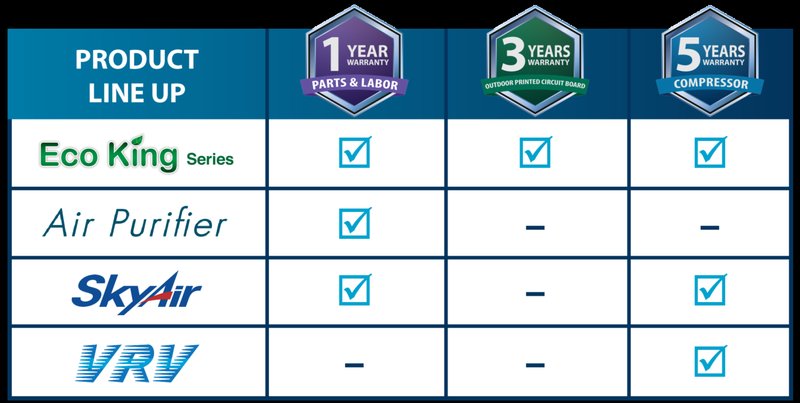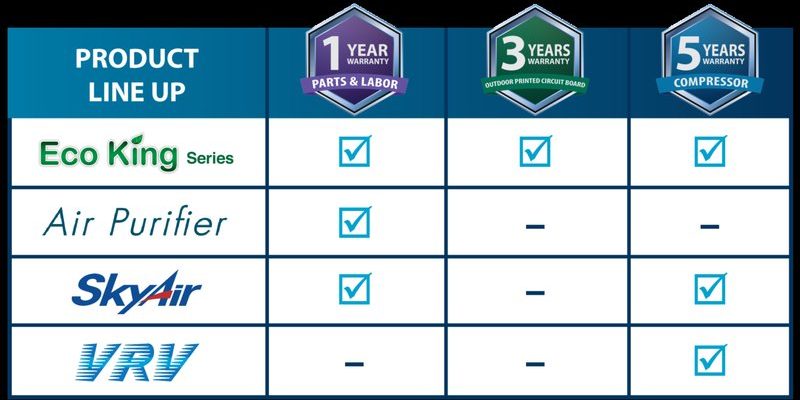
Daikin is a well-known brand in HVAC, praised for their smart engineering and durability. Their warranty acts like a safety net, promising to cover certain parts and repairs for a set time. But here’s the thing: not every part or problem falls under warranty. The coverage depends on the component, the installation, and even how you maintain the system. So, let’s break it down bit by bit so you feel confident understanding what your Daikin HVAC warranty covers and why it actually matters.
Understanding the Basics of Daikin HVAC System Warranties
At its core, a Daikin HVAC warranty is a promise from the manufacturer to fix or replace parts that fail under normal use, usually within a specific timeframe. Think of it like a handshake agreement—you’re not on your own if something breaks due to faulty equipment. Daikin generally offers a **limited warranty**, which means they cover certain components but not everything. This is pretty standard for HVAC systems.
Most Daikin warranties split the coverage between the **compressor**, the **refrigeration system**, and **other parts** like electronics or controls. Compressors usually have longer coverage because they’re the heart of the system, working hard to keep you comfortable. The exact warranty length can vary—typically, you might see 5 to 12 years depending on the model and registration status.
Here’s a useful tip: sometimes, the warranty starts ticking the moment the unit ships, but more often it begins when the system is installed and running. That’s why you’ll hear about “warranty registration”—a quick process to sync your system’s serial number with Daikin’s records. This can even extend coverage beyond the default period in some cases.
What Components Are Usually Covered by Daikin’s Warranty?
Compressors get special attention in the warranty world. Since they’re the powerhouse of your HVAC unit, a failed compressor can mean big repairs or even replacing the whole system. Daikin typically offers a **compressor warranty ranging up to 12 years** on selected models if you register your system promptly.
Aside from compressors, most Daikin warranties cover parts like:
- Evaporator and condenser coils: These crucial components help your system move heat around efficiently.
- Electrical components and controls: Think of these as the system’s brain and nerves, enabling it to react to your thermostat’s commands.
- Refrigerant circuits: This includes the tubing and valves that carry the refrigerant fluid.
However, here’s the catch: common wear-and-tear items such as filters, belts, or batteries in remotes usually aren’t covered. Why? Because they’re consumables meant to be maintained or replaced regularly by the homeowner.
What Does the Warranty NOT Cover?
You might assume anything that breaks down is automatically covered under warranty. Here’s where many folks get tripped up. Daikin, like most brands, excludes certain problems or damages from warranty coverage. For example:
- Poor installation or maintenance: If your system wasn’t installed by a certified professional, or if it’s not maintained properly, things can go south fast. Daikin’s warranty won’t cover failures stemming from these issues.
- Damage from accidents or natural disasters: Floods, fires, lightning strikes, or physical damage caused by pets or kids won’t be fixed for free.
- Cosmetic damage: Scratches, dents, or paint issues aren’t typically covered because they don’t affect how the unit functions.
- Improper use or modification: Trying to pair your system with incompatible parts, DIY repairs, or tinkering with the controls outside of recommended settings can void warranties.
So, if you notice your system acting up, don’t hesitate to call your installer or a licensed technician to troubleshoot before things get worse. Remember, improper troubleshooting or resets on your own might cause more harm than good.
Why Registering Your Daikin HVAC System Matters
Honestly, registration might seem like a boring formality, but it’s your ticket to unlocking the full warranty benefits. Daikin often requires customers to register their system within a certain number of days after installation—usually 60 or 90 days—to qualify for extended coverage, especially on those longer compressor warranties.
You can register online or through your dealer. During this process, you’ll share details like your system’s serial code, installation date, and installer info. Once registered, Daikin syncs this data with their records, so you’re covered in case you need a replacement or repair.
If you skip registration, you usually get a shorter warranty, often only the basic 5-year parts coverage. So, it’s definitely worth a couple minutes to complete it. Plus, registered owners often get access to special service programs or recall information.
How to File a Warranty Claim with Daikin
Here’s the thing: filing a claim isn’t as scary as it sounds, but it does require a little patience and the right steps. When your HVAC system shows signs of trouble, first contact the company or technician who installed it. They’re usually the go-to for diagnosing issues and starting the warranty process.
You’ll likely need to provide:
- Your **warranty documents** or proof of purchase
- The unit’s **serial number and model number** (usually found on a label on the unit)
- Details on the problem, including what troubleshooting you’ve tried (like resetting or checking the remote)
Once your claim is submitted, Daikin or the dealer will determine if the issue is covered under warranty. If approved, they’ll arrange repairs or part replacements at no cost (beyond any service fees that aren’t covered). It’s important to keep records of all communication and receipts to avoid delays.
Comparing Daikin’s Warranty to Other HVAC Brands
You might be wondering how Daikin stacks up against other brands like Carrier, Lennox, or Trane. Honestly, Daikin’s warranty terms are competitive, especially when it comes to compressor coverage for registered units. Many brands offer a **5-year parts warranty** as standard, but Daikin’s can go up to 12 years with registration for certain models, which is impressive.
That said, some brands offer optional extended warranties or service plans that cover labor costs, which Daikin’s standard warranty doesn’t always include. So, it’s good to ask about those add-ons at purchase time.
Another thing to keep in mind is that Daikin’s warranty focuses on quality manufacturing defects rather than damage from user errors or environmental factors. So, if you’re thinking about universal remotes or third-party add-ons, make sure they don’t void your coverage.
Maintaining Your Daikin HVAC System to Preserve Your Warranty
Warranties don’t mean a free pass to neglect your HVAC system. In fact, **proper maintenance is essential** to keep your warranty valid. Daikin warranties usually require that routine care—like changing filters, cleaning coils, and inspecting electrical connections—is performed regularly by a licensed professional.
Here’s why it matters: without regular checkups, minor issues can grow into costly breakdowns that won’t be covered. Plus, maintaining your system boosts efficiency, lowers energy bills, and keeps your home comfy.
If you ever need to reset or pair your system’s remote control or troubleshoot error codes, make sure you follow the manufacturer’s instructions closely. Messing with codes or battery replacements might seem small, but it can impact your system’s operation and potentially void warranty claims.
—
Daikin’s HVAC warranty is a solid safety net that protects you from unexpected repair costs on key parts of your system, especially the compressor. But, like any warranty, it’s got boundaries—you have to register your system, keep up with maintenance, and avoid DIY fixes that could complicate things. Think of it as a relationship: Daikin’s got your back when their gear works as intended, and you’ve treated it with care.
Next time you glance at your Daikin HVAC warranty, you’ll know what it really means—more than just a piece of paper, it’s a promise and a guide for keeping your home comfy for years to come.
